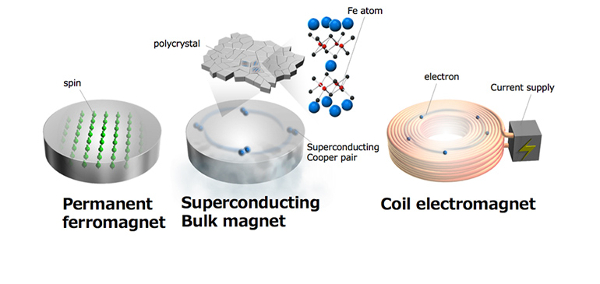By Kristen Roberts, MagLab
TALLAHASSEE, Fla. — An international research team from the National High Magnetic Field Laboratory (National MagLab) and the Tokyo University of Agriculture and Technology is the first to use an iron-based high-temperature superconductor as a strong magnet. Their findings are published this week in the journal Superconductor Science and Technology.
After magnetizing the iron-based superconductor and then turning off the magnetic field, the research team was able to maintain, or trap, a 1-tesla field within the material, essentially creating a permanent magnet about the strength of a junkyard magnet (capable of lifting a car).
"It is exciting to see this new group of superconductors that do not contain any rare earth elements trapping such a high field," said Eric Hellstrom, a researcher at the National MagLab's Applied Superconductivity Center who was involved in the experiment.
Iron-based superconductors were discovered fewer than 10 years ago and have piqued scientists’ interest because they do not follow the rules of traditional superconductors.
"This is a recently discovered class of superconductors that we are working to understand," said Jeremy Weiss, a recent PhD graduate in materials science and engineering from Florida State University who is now a postdoc at the University of Colorado, Boulder. He fabricated the potassium-doped barium iron arsenide (Ba,K)Fe2As2 sample, known as barium-122, at the Applied Superconductivity Center.
The 1-centimeter sample was created by combining many small crystal grains together using a specialized heat treatment process that is traditionally used on ceramics, another class of high-temperature superconductors. Because of the sample's polycrystalline structure and the convenient fabrication process, researchers believe they could make a barium-122 sample that is much larger and has the potential to trap even higher fields — possibly up to 10 tesla — in the next several years.
Superconductors are materials that carry electrical current with little or no resistance when cooled below a certain temperature. Powerful superconducting magnets are currently used for magnetic resonance imaging (MRI) and other high-tech medical and energy applications. However, these superconducting magnets require cooling to very low temperatures, a process typically done with limited and expensive liquid helium.
Iron-based high-temperature superconductors, though, can be cooled much more easily using compact, commercial cryocoolers. This makes them smaller, portable and flexible for numerous applications including medical MRI, new generation nuclear magnetic resonance systems, high-energy accelerators and high-efficiency superconductor motors.
The research was supported by the National Science Foundation and the Japanese JST-PRESTO and JSPS.
How they made the magnet
There are different ways of making magnets, as shown in the illustration below.
The magnetic field in ferromagnetic permanent magnets — like those on your refrigerator — is due to aligned electron spin: All the electrons in the material are lined up in the same direction. A few materials naturally have this property. You can also make permanent magnets by exposing certain materials to an external magnetic field.
In electromagnets, like the large research magnets scientists use at the MagLab, the magnetic field is created by flowing lots of current from an external power source through coils made of a copper-silver alloy.
In superconducting bulk magnets, like the barium-122 magnet, the magnet is formed from a block of the superconducting material. The magnetic field is due to current flowing in loops within the superconducting material, just like in electromagnets. But this current flow is induced by an external magnetic field, as is done in a permanent magnet.
Because the current does not decay in the superconducting bulk if it is kept very cold, it can be used as a permanent magnet. The energy density from current flow in the superconductor is 100 times greater than in copper, so very powerful superconducting magnets that are very small in size are possible.
